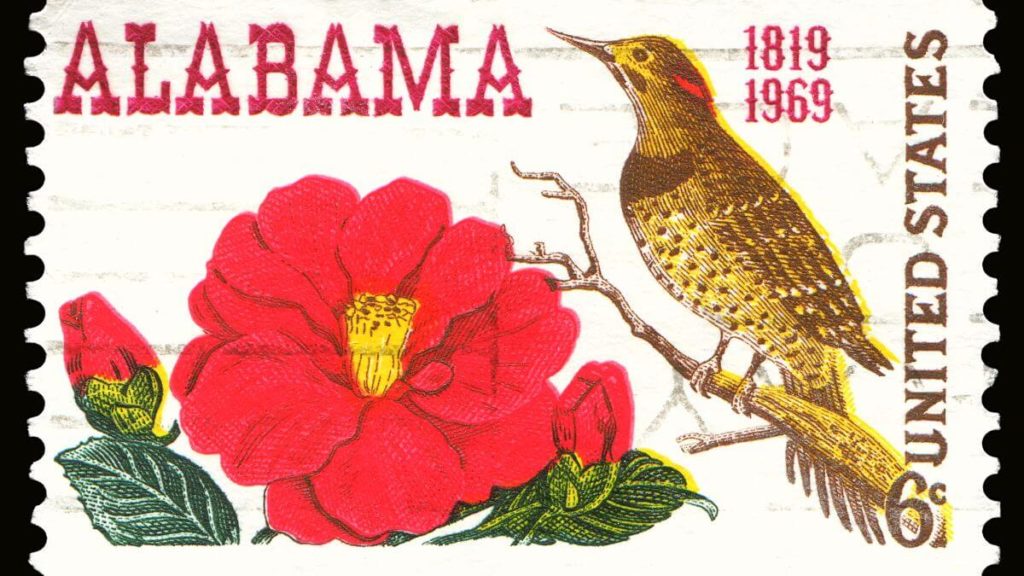
If you a birder and visiting Alabama, you might wonder what the most common birds of Alabama are. Good news. Alabama’s diverse landscape, from the Appalachians, the Tennessee River Valley, plains, swamps, river deltas, and lakes, make it a diverse home for more than 250 different species of birds. Dedicated birders have spotted up to 300 different types of birds. This makes Alabama a prime birding territory among the lower 48 states.
Alabama has two state birds. The Northern Flicker is the official state bird (yellowhammer as they call it), while the Eastern Wild Turkey is the state’s official game bird.
If you are serious about birding, it would be wise to buy a book on the subject. This will save you many hours of figuring out where to go birding, what to look for, and how to identify the birds you see.
- Tekiela, Stan (Author)
- English (Publication Language)
Birds of Alabama Field Guide is the most widely-used birding field guide specific to Alabama. There are others, but if you conduct a search you will find most birders prefer this guide.
Bird Migration In Alabama
The waters and forests create a tempting home for very different types of birds, such as those by the shore and the various raptors inhabiting the forests. Alabama’s moderate climate helps make the state a natural aviary breeding ground. Northern birds that migrate south for the winter tend to pass through Alabama or remain in the state for a while, greatly increasing the local bird count.
Alabama birds can gravitate toward the wetlands and swamps due to the accessibility of water, which is especially important during the summer months. In swamp areas such as the City of Alabaster, birders can easily spot the Bobolinks, Anhinga, Dickcissels, Eastern Bluebirds, Mourning Doves, and Grasshopper Sparrows. Migratory sandpipers, herons, and Lesser Yellowlegs can be spotted here. There is a deck in the park for easy access to the birds. As a bonus, the local butterflies are gorgeous.
The raptors and herons love to make themselves at home in the park’s dead trees. Since the swampy area attracts insects as well as birds, birders should use repellent and wear appropriate clothes.
Alabama’s Dauphin Island is one of the U.S.’ major migration stops and a favorite for bird-watching tours eager to spot the warblers, scarlet tanagers, orioles, and indigo buntings. Birdwatchers near the shore are sure to spot the egret, frigatebird, heron, and piping plovers. Those are just a few of the more than 215 transitory birds.
6 Most Common Birds in Alabama
The state’s most common birds are as follows:
- American Robin – it has a beautiful red breast with a darker back and head. These beauties inhabit the forests and plains and routinely visit people’s backyards. They frequently nest near human habitation and produce three to five lovely eggs.
- Downy Woodpecker – these are black and white birds, with males displaying a red spot on their heads. They frequent areas with people and birdfeeders. The Hairy Woodpecker, also in Alabama, looks identical to the Downy Woodpecker, and birdwatchers can be challenged in telling these two species apart.
- American Goldfinch – as the name implies, these birds are a bright yellow color. A rarity in the bird world, the Goldfinch is a vegetarian who eschews worms and insects while surviving on seeds
- House Sparrow – these birds are predominantly black and brown, with the females having a slightly duller hue. The tan line by their eyes is a favorite identifying mark. They commonly live among people and feed themselves with human foods, such as tossed popcorn or bread.
- House Finch – the male has a red hue around the head and breast, with a brown back, belly, and tail. The female lacks the red coloring. Like sparrows, finches live in populated areas such as yards and parks.
- Blue Jay – this bird is famed for its stunning blue feathers. Its belly is white, and its neck has a black stripe. They are the only bird that will crack a peanut open to get at the nut inside.
Common Birds of Alabama by Color
Trying to identify a bird in Alabama by color? The following birds, sorted by color, are common throughout Alabama. Odds are high the bird you’re looking at is one of these.
Black Birds in Alabama
Ravens in Alabama
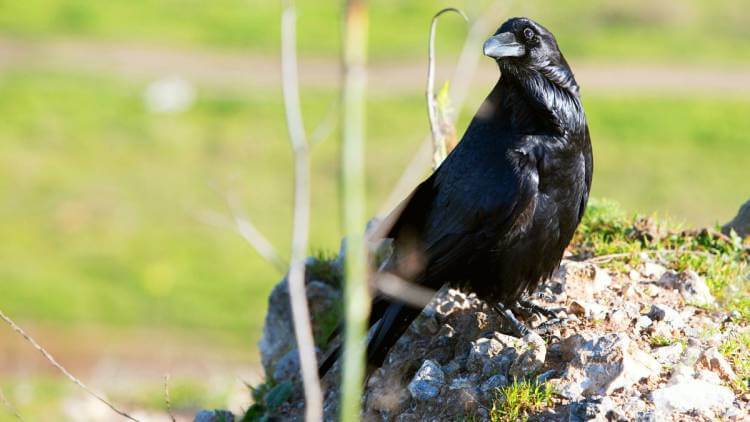
The common Raven can be found throughout the U.S. They are songbirds and surprisingly, they are related to the colorful jays. Ravens can grow large, over four pounds. They usually avoid humans and remain mostly in wilderness areas, mountains, forests, and grassland. They feed on smaller birds, eggs, berries, and shellfish. In coastal areas, they will compete with gulls for food. Ravens are monogamous birds and pair for life. They live up the 15 years in the wild. They may be the only bird species able to count.
Common Grackle in Alabama
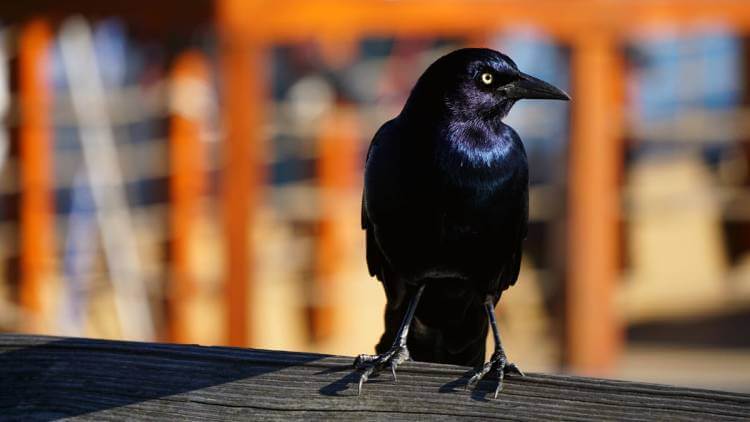
The Common Grackle can be found year-round in Alabama but is most frequently spotted during the summer months. They are a tall breed of blackbird, with a blue sheen on their black feather. As is usual in the bird world, the male has more gloss than the female.
Grackles are often confused with Starlings (know the differences). Grackles are known to be audacious little thieves, not hesitating to steal food out of the mouths of other, smaller, birds. They feed on mice, frogs, seeds, eggs, and insects.
Brown-Headed Cowbird in Alabama
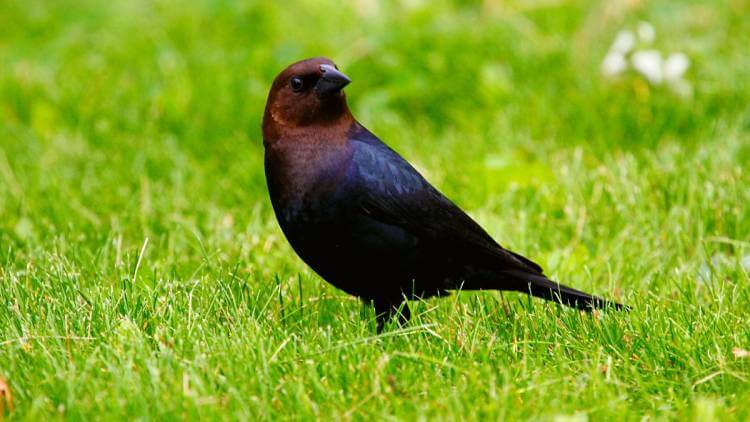
The Brown-Headed Cowbirds can be easily spotted from March through July. They have a black-feathered body with a brownish head. They will feed on seeds and insects.
They are a small blackbird, with a lovely blue sheen to their wings.
Cowbirds are parasites. Instead of building their own nest, they lay their eggs in other birds’ nests, sometimes eating the host bird’s own eggs. They leave the raising of their chicks to other birds. Probably out of necessity, the chicks grow quickly and learn to get their own food within a few days.
Pileated Woodpecker in Alabama
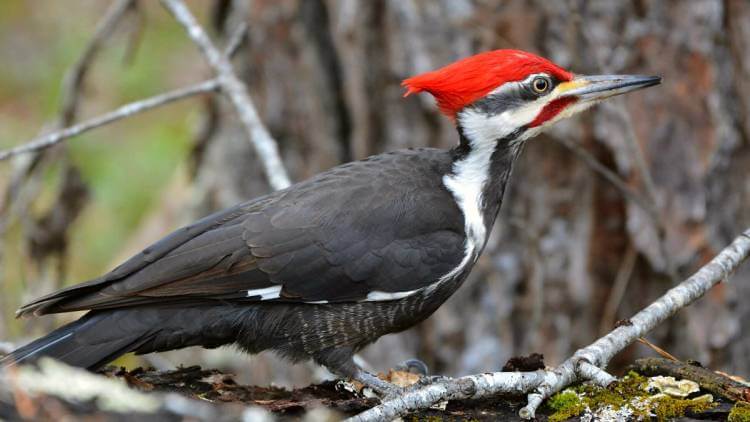
At 17 inches tall, the Pileated Woodpecker is the second-largest woodpecker in the U.S. It has a black body with white neck and wing patches. It displays a crowning red crest on its head.
Pileated woodpeckers live in forests, rarely venture to more urban areas, and dine on carpenter ants and beetle larvae. The tree cavities made by the pileated woodpeckers make a suitable home for other birds, such as owls. Dead trees are usually filled with carpenter ants and finding a dead tree frequently will lead a birder to a Pileated woodpecker.
The male and female Pileated woodpecker can be distinguished from the red mustache on the male, which the female does not have. Pileated woodpeckers mate for life.
The Alabama Pileated woodpecker is frequently mistaken for the ivory-billed woodpecker, which has become extinct in the state.
Blue Birds in Alabama
Black-throated Blue Warbler in Alabama
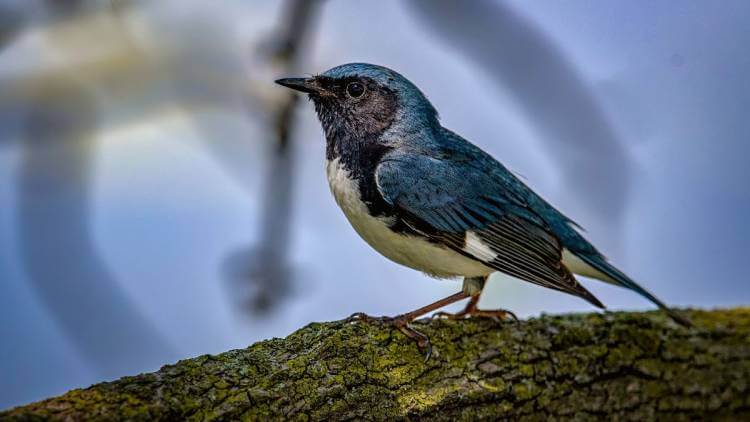
The Black-throated Blue Warbler prefers forests with dense undergrowth. Although they mostly keep to themselves, they are not shy, and birders who walk a forest trail quietly can frequently spot them.
The Black-throated Blue Warbler feeds on insects from the underside of leaves. Males feed higher up in the trees; females forage lower down. They also feed on seeds and insects.
The female lays around four eggs at a time, which the Cowbirds, contrary to their usual habit, won’t parasite because the nests are too far within the forests. They usually have up to three broods per season.
Eastern Bluebird in Alabama
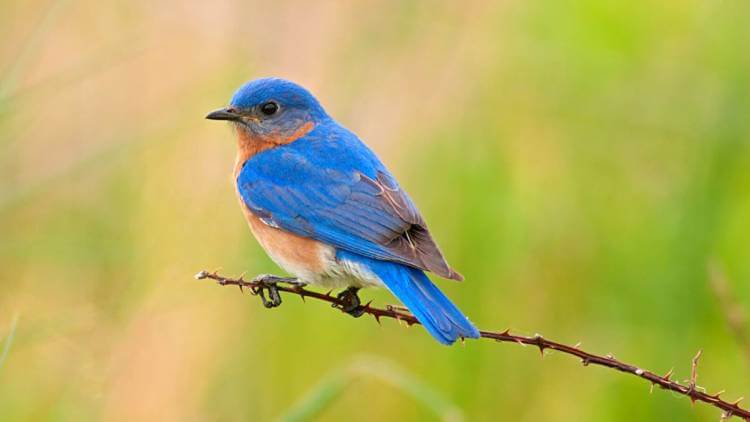
The Eastern Bluebird can be found year-round in Alabama. They have a musical quality that is easy to identify.
Contrary to many Alabama birds, the Eastern Bluebird prefers grassland and orchards and is a common sight near golf courses. They feed on insects, small berries, and worms and will feed from a garden bird feeder filled with mealworms and berries.
Blue Grosbeak in Alabama
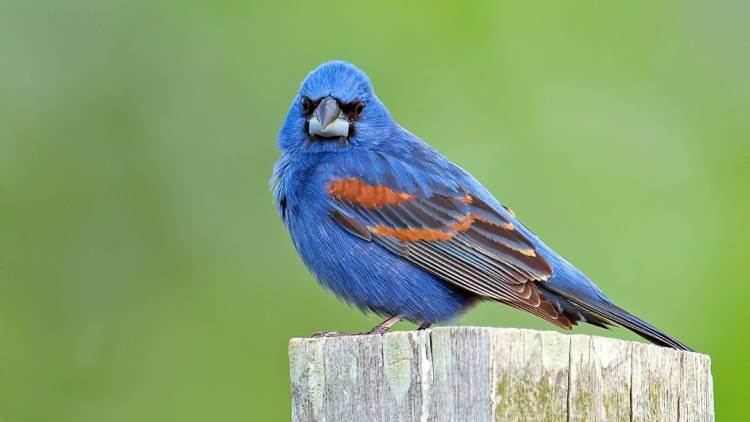
The Blue Grosbeak can be readily identified by its large, triangular bill. The male is a rich blue with a black and silver beak. The female is less vivid with a cinnamon-brown body and a blue tail.
They can be lured to bird feeders with sunflower seeds, which they enjoy. They tend to be elusive and not easily spotted. The sideways twitching (an iconic habit of the Grosbeak) can sometimes help identify them.
Orange Birds in Alabama
Barn Swallow in Alabama
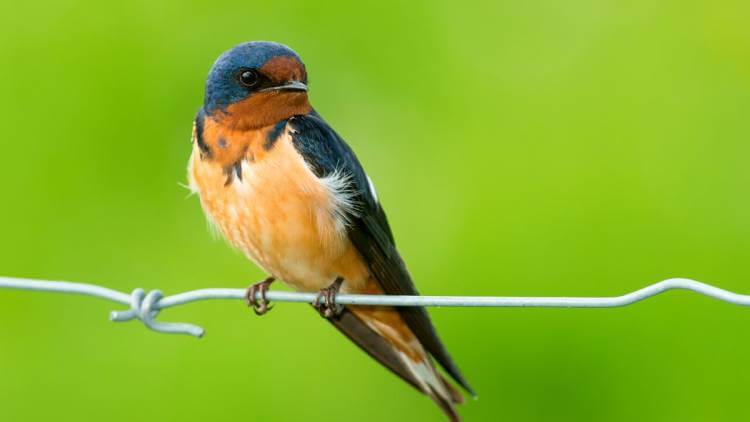
The colorful Barn Swallow has blue wings and a bright orange underbelly. The female’s underbelly is tawnier. The barn swallow’s long, forked tail is very noticeable and differentiates it from other swallows. Instead of living in trees, they erect their mud homes on human-made sites, frequently barns or stables. Sometimes, they will build a home beneath a bridge. To locate them, birders should search within man-made structures instead of trees.
They spend their time in fields and farms searching for food. During nesting season, they can be spotted in the mud looking for grass and mud to create their mud homes.
Unlike most Alabama birds, the Barn Swallow is not tempted by bird feeders. For the most part, it feeds on flying insects, which they snap up in mid-air. They will also eat grasshoppers.
Blackburnian Warbler in Alabama
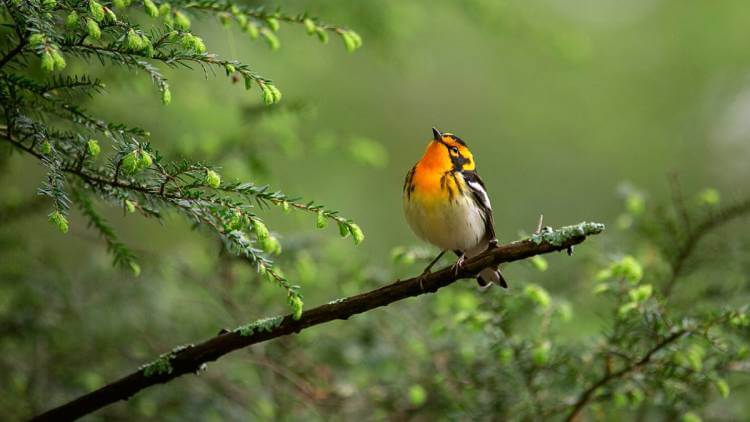
Alabama birders can find the Blackburnian Warbler along the Coastal Birding Trail during their seasonal migration. They spend the summer in Alabama before migrating south and build their nests in mixed forests. They enjoy perching high up, where the male proudly displays his orange throat as he warbles his songs. The male uses his voice during courtship.
They feed on insects, ants, spiders, and caterpillars.
Yellow Birds in Alabama
American Goldfinch in Alabama
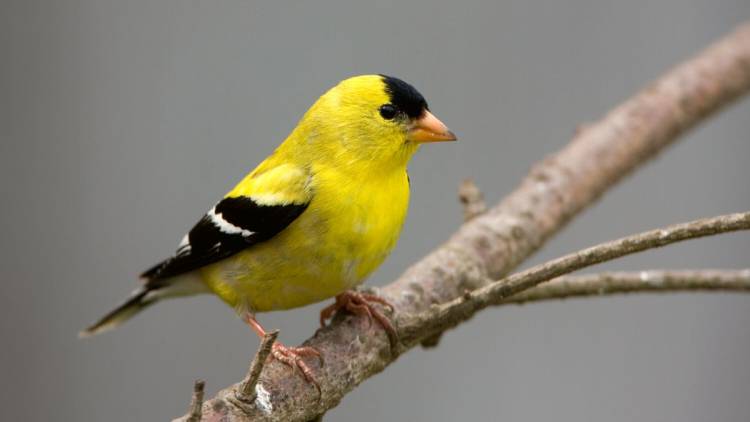
The American Goldfinch is small with a short bill, short tail, and long wings. The male, especially during courtship time, has shiny yellow and black wings and forehead. As is usual in the aviary world, the female is duller in appearance. They can be found throughout Alabama, mainly in the northern part of the state.
The Goldfinch lives in fields and low-lying river areas, where they can find thistles and asters. They also make themselves at home in orchards and backyards. During the winter months, they take advantage of bird feeders, especially if offered sunflower seeds.
Common Yellowthroat in Alabama
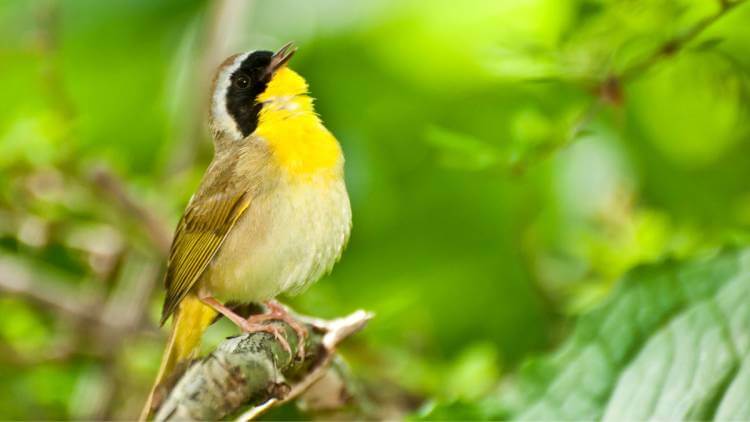
The Common Yellowthroat male has a bright yellow underside and upper parts that are more olive in color. He stands out due to the black mask around his face, making the Yellowthroat the Zorro of the bird world. The females usually have some yellow shading around the throat; otherwise, they are more olive in color and do not have a black mask.
The Common Yellowthroat is not a tree inhabitant; instead, the species can be found in marshes and wetlands. They will nest in shrubbery near streams and prefer wetter areas to drier ones. Insects are their food of choice, and they will frequently catch their dinner in mid-air.
Eastern Meadowlark in Alabama
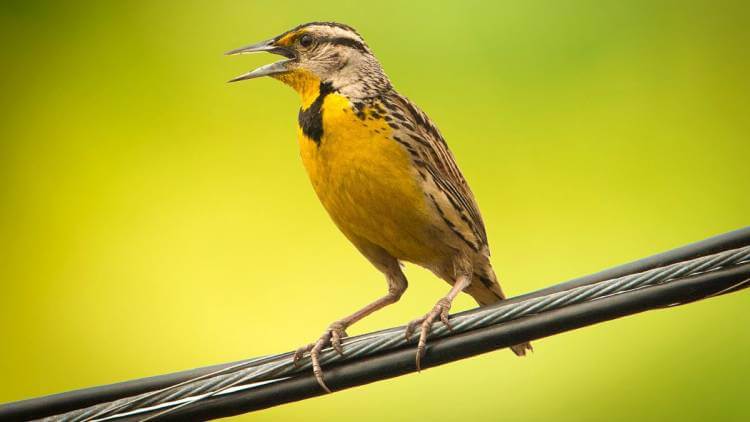
The Eastern Meadowlark is medium-sized and has a wingspan of 15 inches. The male has a yellow underbelly with a black “V” across the chest and a long, pointed bill. Both the male and the female meadowlark grow duller in color during the winter.
They can be found throughout Alabama all year round. They like open fields, such as meadows, golf courses, and open fields but do not venture into dense forests or even shrubs. The Eastern Meadowlark will perch on fences, tall grass, trees, and wires. Nests are usually built in tall grass that is between 10 and 20 inches tall. They feed on insects, seeds, and grains.
Common Birds of Alabama by Species
Owls in Alabama
There are several different types of owls that make their home in Alabama’s diverse landscape.
Barn Owl in Alabama

The Barn Owl, or the Tyto alba, can be found year-round. The Barn Owl has small eyes, a heart-shaped face, long legs and wings, and a short tail. Their faces and underwings are white, which makes them easy to spot when they are flying. The remaining body can be a golden or cinnamon shade. The male is lighter in color than the female.
They are nocturnal predators and feed on mice, rats, bats, rabbits, and other small animals. The Barn Owl doesn’t hoot and hisses and screams instead.
Barred Owl in Alabama
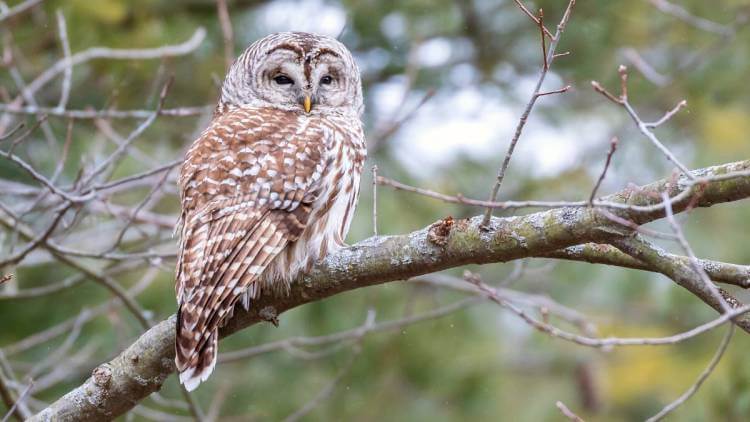
The Barred Owl, or Strix varia, has white and brown shades on its wings and tail and dark streaks on its stomach. Its black eyes can be eerie. Barred Owls can mostly be found near a forest with a river or swampland. They feed on seafood, birds, and amphibians. They will even wade into the water to catch their meal.
The Barred Owl can be found year-round.
Burrowing Owl in Alabama
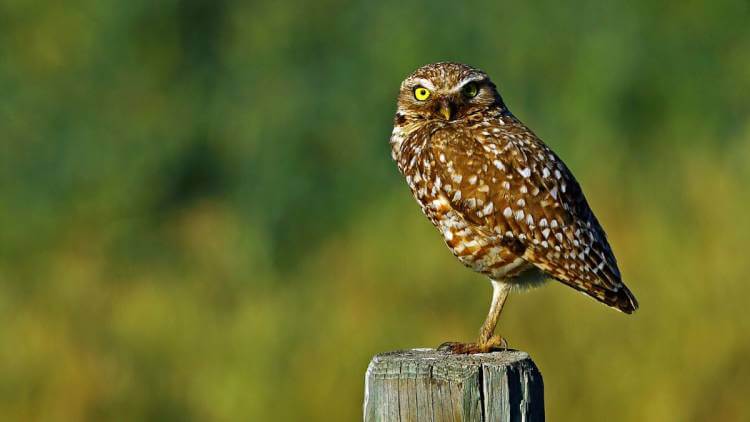
The Burrowing Owl, or the Athene cunicularia, is a small variety of owl, with feathers in various shades of brown and a short tail. Their eyes are yellow-rimmed. Burrowing Owls feed on fish, inspect, rodents, and birds. They prefer living in open habitats such as the beaches of Alabama.
They do not nest in trees. Instead, they take over abandoned burrows from prairie dogs or squirrels. The Burrowing Owl is a rare sight in Alabama, and its brown speckled appearance serves as excellent camouflage. To spot a Burrowing Owl, listen for its dove-like coo-hoo. Unlike other owls, it is likely to be spotted during the daytime.
The Eastern Screech Owl in Alabama
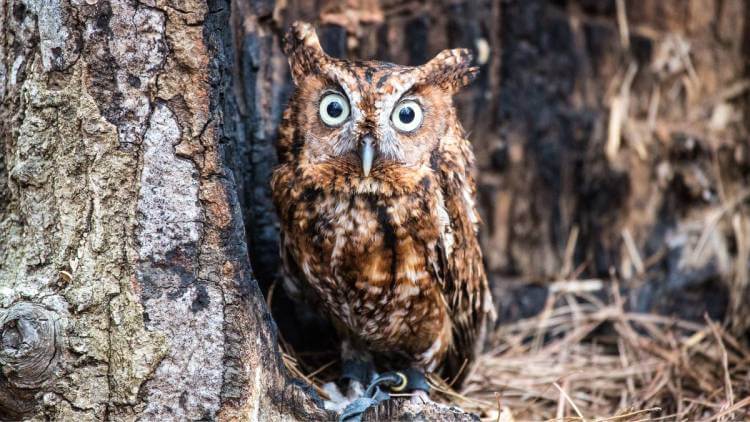
The Eastern Screech Owl, or Megascops asio, lives along the shorelines, woody areas, or the suburbs of Alabama. It feeds on rodents, reptiles, and birds. Its grey-red plumage serves as camouflage during the day. The Alabama Eastern Screen Owl has more red plumage than others of their kind.
The Eastern Screech Owl can be found by listening for its soft, horse-like whinnying. Since they are well-camouflaged, listening for them is the best way to find them.
The Great Horned Owl in Alabama
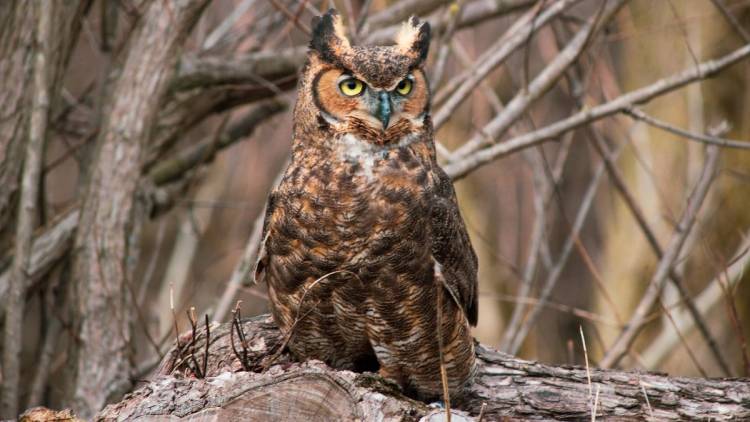
At up to 25 inches tall, the Great Horned Owl, or Bubo virginianus, is the largest of the Alabama owls and can be found throughout the state. Their wingspan is an expansive 60 inches, or even 80 inches, although the male is larger than the female. The Great Horned Owl is brown with noticeable white feathers at the throat. Its face can be orangish or grey, with white feathering between the eyes. Their name is derived from their large, tufted ears.
Hawks in Alabama
Hawks are raptors who live either in woodland or in marshes, depending on the specific breed. Summer is the best time to try and spot hawks in Alabama.
Red-tailed Hawks in Alabama
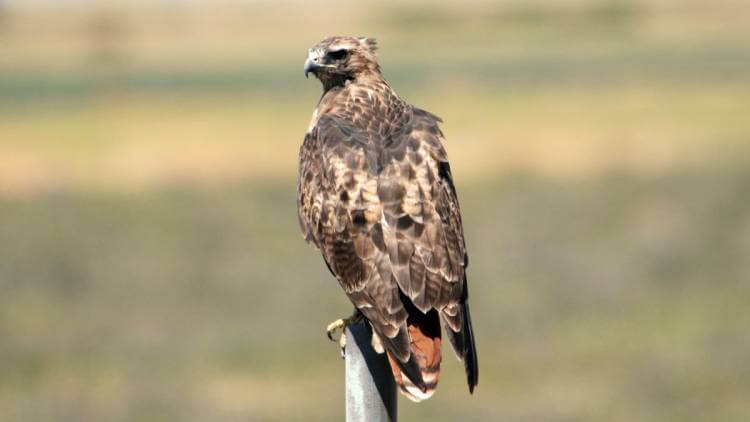
The Red-tailed Hawks, or Buteo jamaicensis, is a year-round resident. Unusual in the bird world, the female is larger than the male. They are Alabama’s largest hawk, weighing up to four pounds with a wingspan of four feet.
Their identifying trademarks are the red-rust tail feather and pale breast feathers sported by the adults. They are frequently found in trees near fields where prey is abundant for them, such as small rodents and rabbits. They enjoy being high above the ground, and nests have been found on skyscrapers.
Red-shouldered Hawk in Alabama
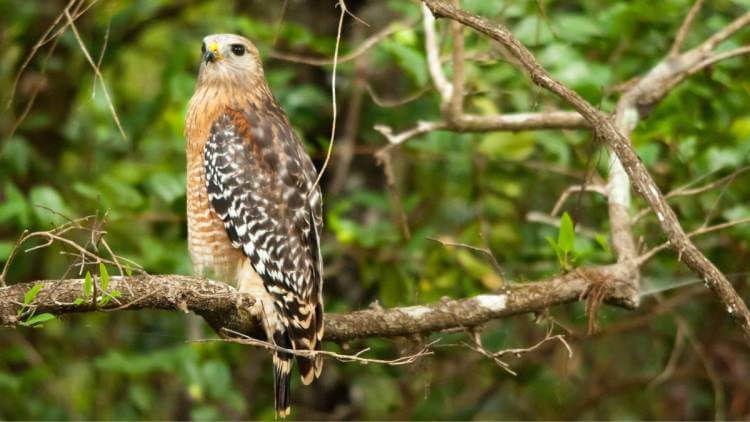
The Red-shouldered Hawk, or Buteo lineatus, can be found year-round in Alabama. This hawk is medium-sized with a 40-inch wingspan. It has brown top feathers, a white belly, with a tail that is both black and white.
They are found near river swamps with small fields. They will perch high, sometimes on a power line, and scan for any movement below. When a prey, such as a small mammal or small bird, has been spotted, the Red-Shouldered Hawk swoops down from his height.
Northern Harrier in Alabama
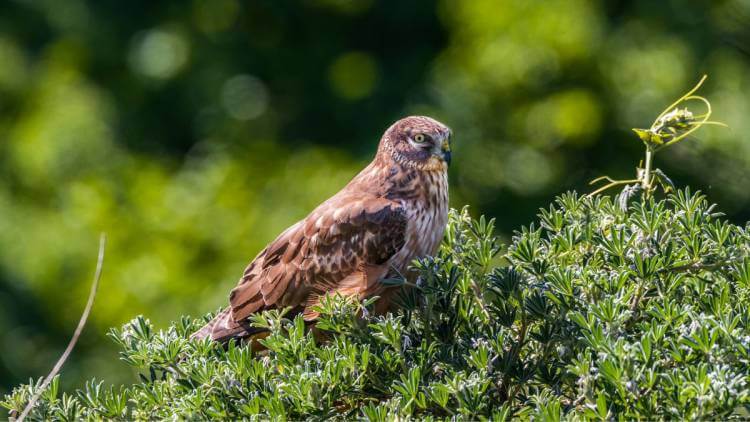
The Northern Harrier, or Circus cyaneus, is now considered endangered, and spotting one is a great treat for birders.
They inhabit marshes and grassland. Males have grey stripes on top with a white underside, while the female is darker above. Their distinguishing feature is a white-feathered rump and black-tipped wings that give them a “gloved” appearance.
The Northern Harrier is medium sized with a long tail. Females are considerably larger and heavier than males. They inhabit mostly wetlands and wet pastures,
To hunt their prey, they fly low in search of rodents, small birds, and insects.
Woodpeckers in Alabama
Alabama is filled with the sound of woodpeckers knocking on wood. They drill into trees in search of food. The noise is also a way to communicate with other woodpeckers.
Downy Woodpecker in Alabama
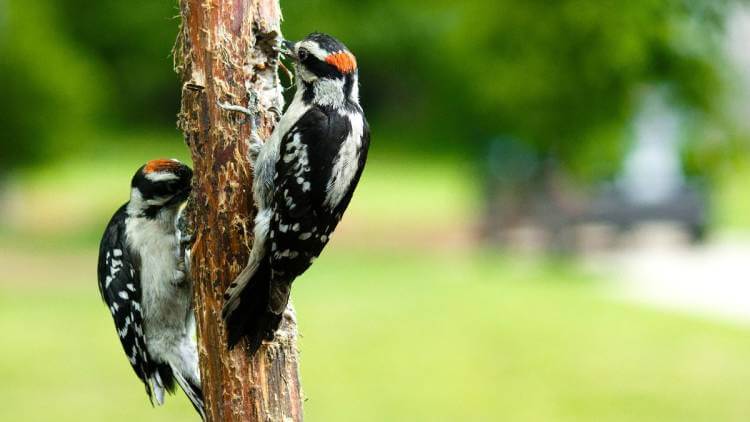
The Downy Woodpecker, or Picoides pubescens, is the smallest Alabama woodpecker. The male has a white belly, a distinctive red spot on his head, and a black bill. They are easily mistaken for the Hairy Woodpecker, who are merely smaller in size. The Downey Woodpecker lives in parks, woodlands, and near rivers, as well as near human habitats. The best way to spot them is at a bird feeder.
They feed on seeds, fruits, and insects.
Northern Flicker in Alabama
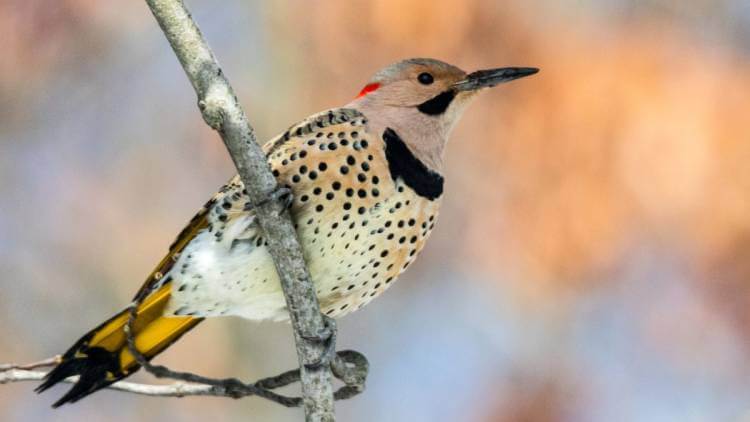
The Northern Flicker, or Colaptes auratus, is also called the Yellow-hammer. It is the state bird of Alabama. These 12-inch woodpeckers are brownish beige with black polka dots, a black band around the neck, and a yellow underwing. They can be found in woodlands with dead trees, which they use as nest cavities. They are also quite common in parks and areas with people, and their drumming can be heard most often early in the morning.
Red-bellied Woodpecker in Alabama
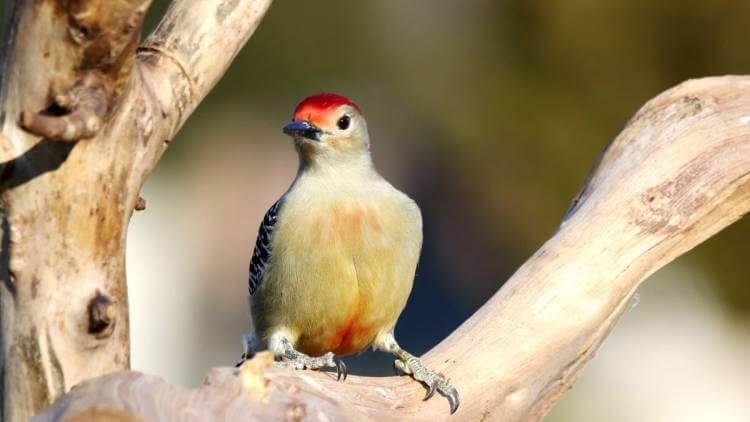
Alabama’s most common woodpecker is the Red-bellied Woodpecker, or the Melanerpes carolinus. It has a wingspan of up to 17 inches. The belly is more pink than red, but the top of its head is a bright crimson. The back has horizontal black and white stripes. A white patch on the feathers makes them easy to spot, and they can be seen throughout Alabama.
The Red-bellied Woodpecker lives in coniferous forests or some suburbs. It feeds mostly on fruits, then insects, acorns, seeds, and ants.
Red-cockaded Woodpecker
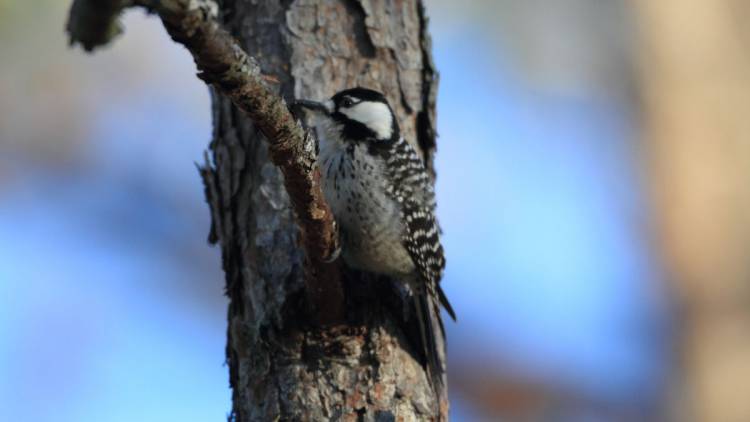
The Red-cockaded Woodpecker, or the Picoides borealis, is listed as endangered. It is seven inches in length and has a wingspan of 15 inches and sports thick white stripes across its back feathers. Its most distinguishing features are puffy white cheeks and underbelly against a black head that strangely resembles a black cap.
The majority of Red-cockaded Woodpecker living in Alabama are in the Oakmulgee, Talladega, and Conecuh National Forests, where they inhabit the local pine trees. They feed on the insects found in these trees, such as beetles, ants, and caterpillars. They will also eat fruits and seeds.
Red-headed Woodpecker in Alabama
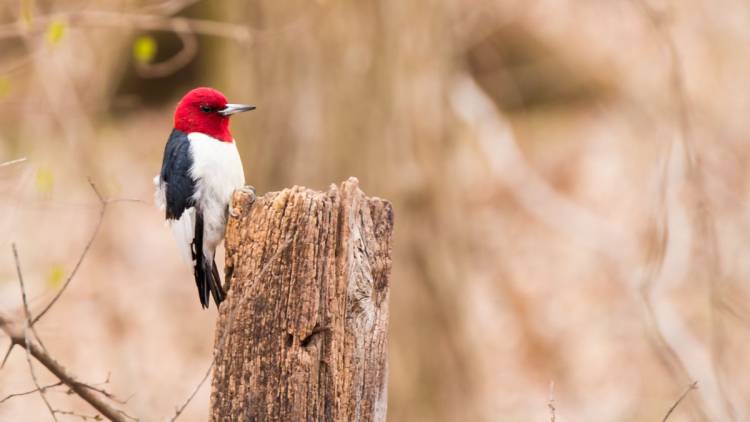
As the name suggests, the Red-headed Woodpecker has a red head that resembles a jaunty cap. This contrasts with a black and white body making it easy to identify. Both males and females of this species look alike.
The Red-headed Woodpecker is unique among Alabama’s woodpeckers in that it rarely uses holes in trees while foraging. Instead, it catches insects while flying. It also forages for other food items such as nuts, fruit, mice, bird eggs, and even young birds. Red-headed woodpeckers are found in a variety of habitats, including urban areas.
More Information
More information on Alabama birds can be found on Alabama Birding Trails, the Alabama Ornithological Society, and the Alabama Audubon. Birders can also contact the North Alabama Birdwatchers Society and the South Alabama Cage Bird Society.
Want to try attracting these birds to your garden? Consider a copy of Native Plant Gardening for Birds, Bees & Butterflies: Southeast.
- Daniels, Jaret C. (Author)
- English (Publication Language)


